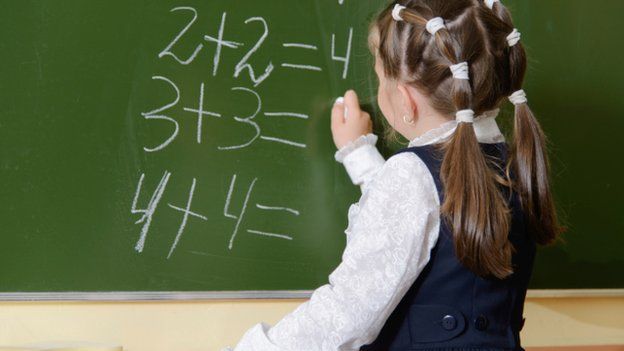New insight into how children learn maths
- Published

Teaching maths using abstract gestures is a good way to help children learn, research suggests.
Eight-year-olds gained a deeper understanding of mathematical principles by using their hands as well as their brains, say US psychologists.
Children were taught to solve formulae such as: "4 + 2 + 6 = _ + 6" by making a V-point beneath the numbers to be added, then pointing at the blank.
The actions helped in generalisation, a report in Psychological Science says.
Previous studies have shown that gesture helps learning.
Psychologists think that when children move and make gestures, they are able to express ideas physically, which helps the learning process.
However, the latest research goes further, suggesting abstract gesture may be a more effective teaching tool than manipulating and touching objects.
Miriam Novack and Eliza Congdon
"Our study found that encouraging children to move, and encouraging them to gesture, more specifically, helps them learn an idea, but in addition helps them generalise that idea," said Miriam Novack, of the department of psychology at the University of Chicago.
"In contrast children who were encouraged to move and manipulate objects fixated too much on those objects and got too focused on the surface features of the problem."
In the experiment, the psychologists taught almost 100 children aged eight and nine a strategy for solving a simple sum.
- In one group, children picked up magnetic number tiles and placed them within the formula on a magnetic whiteboard
- Another group mimed that action without actually touching the tiles
- A third group was taught to use abstract V-point gestures with their hands to group numbers and solve the equations
They then tested the students on similar problems to see how well they understood the underlying principles.
Symbolic interpretation
Only the children who had gestured during the lesson were successful in solving problems that required them to generalise.
Co-researcher Eliza Congdon said the traditional wisdom was that directly interacting with objects was beneficial in teaching.
"What's surprising about our study is that we showed that actually gesture which is a subcategory of movement that doesn't interact directly with objects might be even better in some cases for learning, and potentially for learning abstract concepts like mathematics," she said.
Lead author Susan Goldin-Meadow said the findings provided the first evidence that gesture not only supported learning a task at hand but, more importantly, led to generalisation beyond the task.
"Children appear to learn underlying principles from their actions only insofar as those actions can be interpreted symbolically," she said.
- Published23 January 2014